By Amy Sprague
January 29, 2021
Update April 2021:
Isaiah Cuadras will be attending UCLA to earn a doctorate in atmospheric and oceanic sciences researching ocean turbulence.
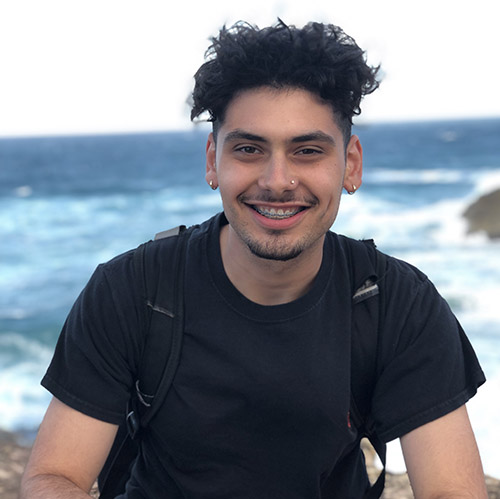
Isaiah Cuadras in Australia for the summer oceanography program sponsored by LSAMP and the College of Engineering.
A summer program in oceanography paved the way for Isaiah Cuadras to apply his interest in fluid dynamics to ocean ecosystems.
A&A student and McNair Scholar Isaiah Cuadras won best undergraduate mechanical engineering presentation for his research at the 2020 SACNAS: The National Diversity in STEM Virtual Conference. Cuadras presented his fluids research in A&A’s Laboratory for Engineered Materials and Structures that is contributing to coral conservation work through a grant with the National Science Foundation. Specifically, he simulated ways to advance coral research in the laboratory by improving the water flow around them, which can create unintended negative impacts on the corals, interfering with accurate research findings.
Cuadras explains, “In coral research, chemists and biologists try to identify the corals’ response to chemical stressors to correlate the changes in the chemical composition of the ocean and the effects of climate change on corals going forward. However, the test environments may subject the coral to water flows that are too fast and unfortunately harm the coral, so it is difficult to figure out what is causing stress and damage.”
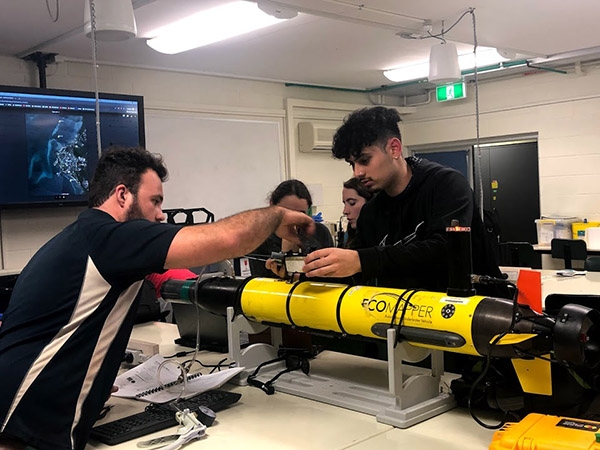
Ecomapper: Cuadras (right) working on the autonomous underwater vehicle “Ecomapper” as part of the summer oceanography program in Australia. The Ecomapper records salinity, pH, and more. Here, Cuadras is attaching a camera to record footage for the Ecomapper’s upcoming project to investigate seagrass beds.
The solution Cuadras is working on is to optimize a “coral-on-a-chip,” a millifluidic device which channels water past the corals and tempers the flow and reduces stress on the corals. Cuadras notes the technical term for this is “reduces dynamic shear stresses.” Cuadras performs simulations through computer programs which can then be translated into building a better millifluidic device in the future.
Inspiration
Isaiah Cuadras was long interested in aerospace when he participated in a study abroad program focusing on oceanography, led by Oceanography Research Scientist Rick Rupan and then-PhD student Isaiah Bolden and sponsored by LSAMP and the College of Engineering, which introduced him to ocean conservation strategies. The previous year, Professor Jinkyu Yang led the Australia summer program with an emphasis on aerospace structures inspired by origami, and through the program, Cuadras learned about Yang’s work in the Laboratory for Engineered Materials & Structures.
With this introduction, Cuadras contacted Professor Yang, who was leading the UW effort under a new grant by the National Science Foundation for coral research. Cuadras’ interests in both aerospace systems and ocean conservation came together with this interdisciplinary opportunity.
Says Cuadras, “This was the first time I saw research involving both fluid dynamics and biological systems.” The McNair Scholar, who thanks that program for helping him prepare to present his research at the SACNAS conference, plans to pursue a doctorate in oceanography, applying his fluid dynamics background to examine how ocean currents affect biological systems and the global climate.
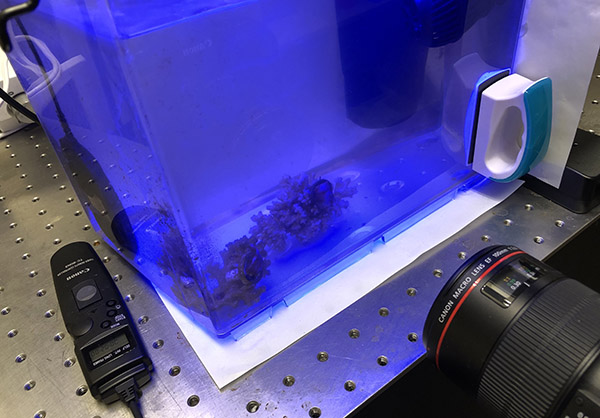
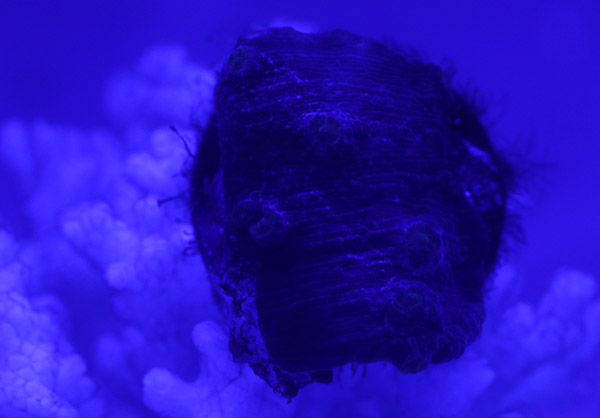
Currently the corals under observation in the LEMS Lab are in a tank. Isaiah Cuadras’ research opens an avenue for observation of very small fragments of corals in the coral-on-a-chip millifluidic device. Water from this tank will filter into the device.
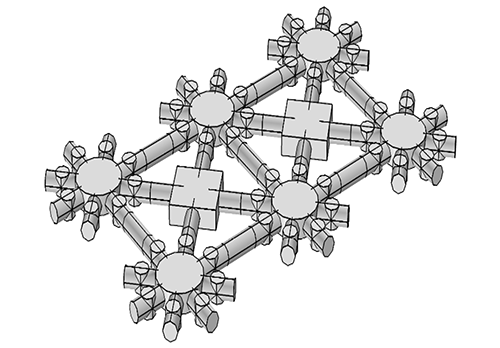
The “Coral-on-a-chip” millifluidic device design that Cuadras adjusted to improve coral research. The device runs saltwater through it and integrates several complex laboratory functions and allows for observation of micro-scale interactions between corals and their environment in the lab. Coral would live inside the circular wells, measuring about 1.6cm in diameter. This entire device is about 16cm long and 10cm wide.
Associate Professor Jinkyu “JK'' Yang puts Cuadras’ research in context, "Marine biologists started using a coral-on-a-chip technology, which is useful in studying corals but still has substantial challenges, particularly in its optimal design. Isaiah’s computational fluid dynamics simulations on a new coral-on-a-chip device we are developing in collaboration with Professor Natassja Lewinski’s group at Virginia Commonwealth University saved us a tremendous amount of time and effort in the design stage.”
A&A graduate student Shuaifeng (Scott) Li mentored Cuadras through this research and said, “I am very impressed by his effort and work. Especially given that Isaiah is only an undergraduate student, he learned finite element analysis and fluid mechanics in a very short time. His research makes it possible for us to directly observe the microscopic live coral polyps, and his adaptations will benefit labs working on coral around the world.”
This research is sponsored by the National Science Foundation’s Office of Cyber Infrastructure for “Harnessing the Data Revolution Big Idea” (Award #1939249) in partnership with Professor Natassja Lewinski in the Department of Chemical and Life Science Engineering at Virginia Commonwealth University. This research combines aerospace engineering, computer science, materials science, data science and biology to capture data on the coral’s manufacture of calcium carbonate structures (similar to 3D printing), how they heal damage to these structures, and how they create environments and co-exist in symbiosis with scores of other organisms. This research will produce large amounts of data that will be analyzed to determine key molecules involved in coral processes and predict and manipulate coral behaviors to aid recovery.